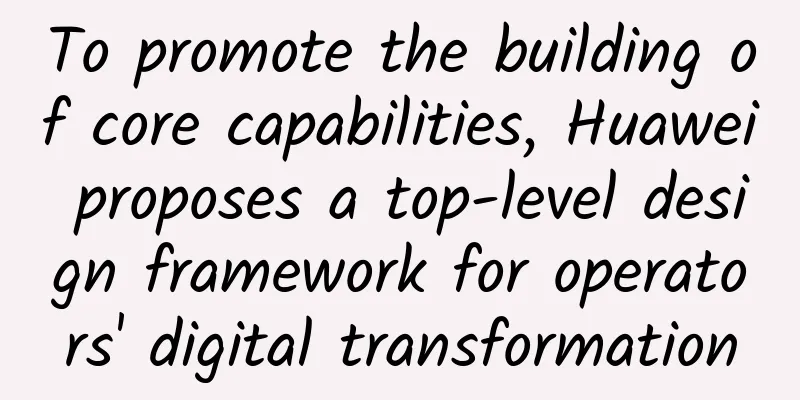To promote the building of core capabilities, Huawei proposes a top-level design framework for operators' digital transformation

|
Today, at the MWCS 2021 media analyst pre-communication meeting, Shi Jielin, Vice President of Huawei Cloud and Computing BG and President of the Marketing Department, delivered a keynote speech entitled "Building New Capabilities for Digital Transformation and Enabling Intelligent Upgrades in Thousands of Industries", proposing a top-level design framework to help operators with digital transformation, relying on a new generation of digital intelligent foundation to drive operators to build four core capabilities for digital transformation. With the rapid development and application of new ICT technologies, thousands of industries have generated urgent demands for end-to-end integrated solutions with large bandwidth, low latency, multi-connection network services + ubiquitous computing needs + application integration during their transformation and upgrading, and operators have ushered in new development opportunities. Shi Jilin said: "From a simple network service provider to an integrated ICT service provider, operators have ushered in the best opportunity for digital transformation and building core competitiveness. As the core role in the era of digital transformation, they have become a powerful engine for promoting innovation and change in all walks of life. Huawei has proposed a top-level design framework for operators' digital transformation and upgrading, which will complement the operators' advantageous resources and help operators build cloud and intelligent capabilities on the basis of connectivity, collaborate with the ecosystem, and enable intelligent upgrades in thousands of industries."
Shi Jilin, Vice President of Huawei Cloud and Computing BG and President of Marketing Digital transformation can help operators unify data, restructure processes, achieve agile market launch, network autonomy, and precision marketing, thereby improving efficiency and creating an ultimate customer experience; at the same time, it can build cloud-network-edge collaboration capabilities through unified API capability calls, online and offline ecological integration, and big data analysis, enabling industry innovation. Based on this architecture, building a digital intelligent foundation with data centers and clouds as the core is the key to operators' digital transformation. On this basis, operators can migrate to the cloud in a classified and rhythmic manner based on the value and needs of the business to achieve smooth evolution of the business.
With the support of a digital intelligent base, operators can build four core digital capabilities and seize business opportunities that enable the industry's intelligent upgrade. Digital operations: Gradually migrate traditional operation support systems to the cloud and improve internal operation efficiency through digital tools.
To help operators with their digital transformation and upgrade, Huawei has proposed an advanced top-level design framework and worked with global operators and partners to build an open and win-win digital ecosystem. From infrastructure to digital platforms, and then to end-to-end solution capabilities, Huawei plays the role of "black soil" and enables intelligent upgrades in thousands of industries. |
<<: Will the cloud business of the three major operators surpass Alibaba and Tencent in 2021?
>>: Huawei CEO Ding Yun: Lighting up the future and releasing new value of connectivity
Recommend
The era of increased traffic is here! IPv6+ development will enter a new stage in 2022
In the "Three-Year Special Action Plan to In...
How unified communications technologies can support long-term remote work
[[354214]] Organizations implementing long-term r...
Guidelines for Protecting RS-232 Serial Connections
RS-232 connections are an integral part of serial...
WiFi 6 Blowout Begins
Despite the current epidemic, Xiaomi released a W...
What is a router in a network? Core functions explained
A router is a core element of internet connectivi...
Why is millimeter wave the only way to the 5G era?
According to the 3GPP agreement, 5G networks will...
5G indoor coverage poses problems for office buildings and operators
It’s no secret that 5G cellular is coming, but mo...
Qianxinan Prefecture Government: Green "optical" network, a new style of government office
The Qianxinan Prefecture Government, as an autono...
Speed up 5G trials! The three major operators are all full of enthusiasm
The third-phase specification release conference ...
Where will edge computing investments go?
At the beginning of 2020, edge computing seemed t...
5G construction enters the fast lane, with base stations, applications, and terminals in full bloom
2020 is a critical year for my country's 5G c...
How can you explain the communication protocol in such a simple way?
This article is reprinted from the WeChat public ...
CDN shifts from price war to technology war, will video cloud rewrite the market landscape?
Just as the rise of e-commerce was premised on th...
Review of the optical fiber industry in 2016: The east wind overwhelms the west wind, and quantitative changes induce qualitative changes
[[181005]] For the optical fiber industry, 2016 i...
Ethernet vs. WiFi: A Comparison of Internet Connection Technologies
The world is generally moving from wired to wirel...









